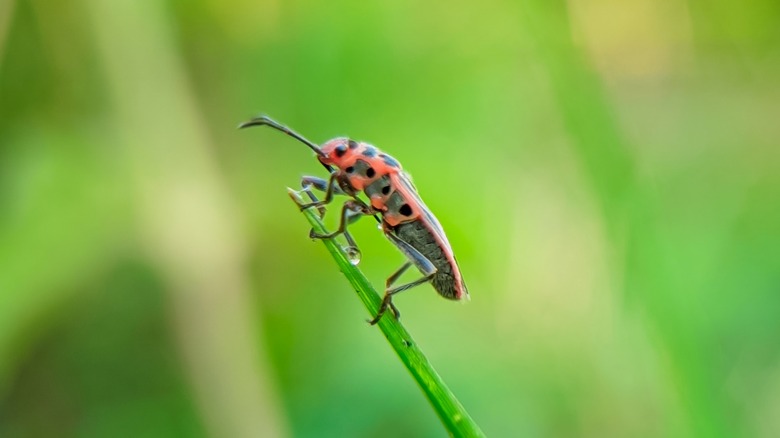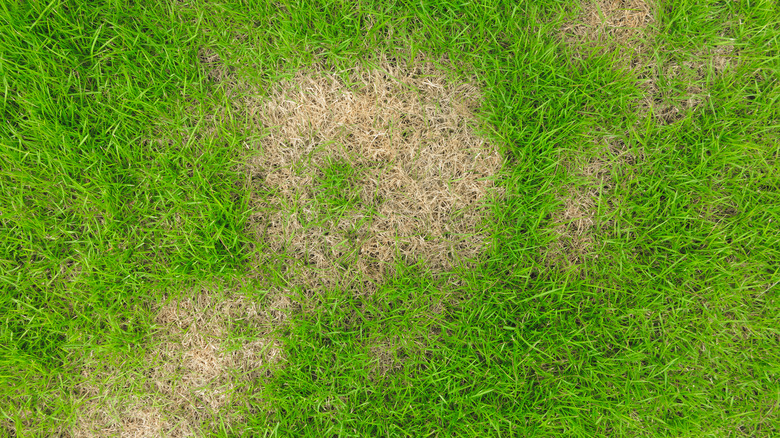Use A Coffee Can Trick To Test Your Lawn For Chinch Bug Infestation
No matter how much you water, mow, fertilize, or reseed, tiny yet ravenous chinch bugs come along and mar your pristine spring turf with their sap-sucking, toxin-injecting mandibles. You've decided to try to prevent chinch bugs from turning your lawn brown with an easy remedy. But how do you know if whatever you've chosen to combat these common turf pests is working? Or indeed, if chinch bugs are causing your grass to die. That's where the coffee can test comes in handy. Simply embed a coffee can, sans ends, into your turf, fill partially with water, and wait to see if any of the dreaded pests float to the top.
Chinch bugs are U.S. natives, yes, but that doesn't stop them being a complete nuisance. Flying adults and ground-dwelling nymphs feed on the roots and stems of grass, simultaneously sucking out the sap and injecting a toxin into the plant. This causes the blade, and eventually the entire plant, to die, filling your lawn with distinctive brown patches. An established population of chinch bugs can wreak havoc on lawns in a matter of months, not years, especially in summer, in sod growing on sandy, quick-draining soils, and during droughts. Species include the southern chinch bug, which particularly likes St. Augustine grass; common (field) and hairy chinch bugs, which munch on Kentucky bluegrass, fescues, ryegrass, bentgrass, and zoysia as well as cereal crops; and the western or buffalo grass chinch bug, which likes, as the name implies, buffalo grass lawns.
Have a calculator at the ready when defining chinch bug numbers
As mentioned, the coffee can test is a go-to method for detecting chinch bugs in residential lawns, one that horticultural experts unanimously consider reliable. Essentially, the idea is that this test will help you confirm whether a bug is to blame for the brown grass in your lawn or whether the degradation is caused by something else. And that's a good thing, right? Pretty much.
Any old, wide, squat tube open on both ends will do — a PVC pipe or a large tin can, for example. Sink the cylinder 3 inches into your dying lawn. Add water — fresh or soapy — with a garden hose or watering can to three-quarters full. Stir the water with a stick to dislodge the grass and soil. Wait between five and 15 minutes for insects to float to the surface to count them. Ideally, do the test in the afternoon, and avoid rainy or cold days when chinch bugs move around less.
One can in a single spot isn't enough. According to lawn experts, checking multiple areas of a dead patch (focusing on the edges) and other parts of your lawn is the only way to get an accurate picture of the infestation. A square foot is roughly equivalent to five coffee cans, so you need to do numerous checks or at least a few calculations to get a useable estimate of the numbers of chinch bugs chowing down on your once pristine lawn.
Chinch bug look-alikes and other conundrums
The chinch bug coffee can test is absolutely worth doing, but that doesn't mean there aren't a few downsides to consider — or perhaps it's better to call them user cautions — before gingerly picking out that empty metal container you just threw into the recycling bin. For one, new-ish research suggests populations of chinch bugs don't often reach the numbers necessary to harm backyard grass. That is, between 20 and 25 insects for every square foot patch of turf. That's why we suggest doing multiple tests covering at least a square foot patch.
There are more conundrums to mull over. Though you might see chinch bugs floating in the water, are they actually what's responsible for damaging your lawn? Big-eyed bugs, native predators of chinch bugs, are commonly mistaken for their prey. To tell them apart, look for the former's distinctive bulbous eyes. If more than half the critters in your test are big-eyed bugs, they're probably already reducing your chinch bug populations. Other imitators include beneficial minute pirate bugs and milkweed bugs; also-lawn-harming hunting billbugs; and false chinch bugs, which eat mostly weeds.
Anyway, the downside with all of this is that if you incorrectly identify and then treat your lawn for chinch bugs with pesticides, you could kill off their natural predator, exacerbating the situation. The best bugs for protecting your garden may suffer, too. Plus, you'll still be in the dark about what's actually causing all of those brown patches.

